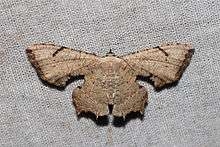Dysaethria quadricaudata
Dysaethria quadricaudata is a species of moth of the family Uraniidae first described by Francis Walker in 1896. It is found in the Indo-Australian tropics from India, Sri Lanka to Myanmar, Taiwan and the Solomon Islands. The habitat consists of lowland forests and disturbed and cultivated areas.
| Dysaethria quadricaudata | |
|---|---|
 | |
| Scientific classification | |
| Kingdom: | |
| Phylum: | |
| Class: | |
| Order: | |
| Family: | |
| Genus: | |
| Species: | D. quadricaudata |
| Binomial name | |
| Dysaethria quadricaudata (Walker, 1861) | |
| Synonyms | |
| |
Description
The wingspan of the male is 24 mm and the female is 32 mm. Adults are uniform pale brown with vinous (wine coloured) frons, and slightly speckled brownish grey. The forewing postmedial line is blackened at the costa and at the dorsum. There is a narrow dark marginal zone to the forewing. Forewings with evenly curved outer margin. A chocolate marginal band runs from apex of vein 3. Hindwings with slight tails at veins 4 and 7. Postmedial line evenly waved and a lunulate submarginal band found between the tails. Ventral side of hindwings whitish.[1]
Larvae dark reddish chocolate and sub-cylindrical. Head heart shaped. Setae black with white spots in front of the dorsolateral tubercles. Ventral surface green with red tinged laterals. Pupa is stoutly claviform (club shaped).
The larvae feed on Adina, Anthocephalus and Cinchona species. They are gregarious and feed from within a webbing that is spun over the leaves. The feeding results in skeletonised leaves. Pupation takes place in a bark crevice or on the ground in a cocoon of loose rusty red silk.[2]
References
- Hampson, G. F. (1895). The Fauna of British India, Including Ceylon and Burma. Moths Volume III. Taylor and Francis – via Biodiversity Heritage Library.
- The Moths of Borneo
| Wikispecies has information related to Dysaethria quadricaudata |
| Wikimedia Commons has media related to Dysaethria quadricaudata. |